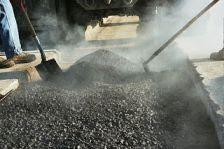Bitumen and bituminous materials
have been known and used in construction works since ancient times, approximately 6000
B.C. Asphalts were used as cements to hold stonework together in boat building and as
waterproofing in pools and baths. Some asphalt was mixed with stand and used to pave
streets and palace floors. The Egyptians made use of asphalt in the mummification process and as
a building material. The Greeks and Romans not only used asphalt as a building material
but also used burning asphalt as a military weapon. The asphalt used by these ancient
civilizations was natural asphalt formed when crude petroleum oils rose to the earth’s surface
and formed pools. The action of the sun and wind drove off the lighter oils and gases, leaving a heavy
residue. The residue was asphalt with impurities such as water and soil present. Using crude
distillation process, cementing and waterproofing materials were obtained.
The word bitumen comes from the
original sanskrit word Gwitumen applied to native asphalts as fuel.
Bitumens are mainly composed of a mixture of high-molecular hydrocarbons,methane, napthane and other
aromatic series and their oxygen or sulphur derivatives. Tar and asphalt are the two varieties of
bituminous materials. Tars are bituminous condensates obtained in the process of
destructive distillation of coal, petroleum, wood and other organic materials at high temperature
without access of air. They are composed of hydrocarbons and their sulphurous, nitrous and
oxygen derivatives. Asphalt on the other hand is a naturally occurring bitumen which is a
combination of an inorganic mineral matter either calcareous or siliceous and an
organic matter—a chemical compound of carbon and hydrogen.
Bitumens and bituminous materials
are being extensively used in damp proofing the basements, floors, roofs, damp proof courses;
painting timber and steel structural elements as adhesives and
caulking compounds, and tars are used as binders in road works. When combined with aggregate these are
also used to provide floor surfaces. Bitumens are now more commonly used
for building purposes than is tar.
Tar
 |
| Tar |
It is a dark (deep black) viscous
liquid produced by destructive distillation of organic material such as coal, oil, lignite and
wool. Depending upon the source of origin it is classified as coal tar, wood tar and
mineral tar. Tar is restraint to petroleum-based solvents. It has very low bitumen content.
coltar is obtained, as a by product in
the destructive distillation of coal, or in the manufacture of coal gas. It is
heavy, strong smelling and black. These generally have high specific gravities and
viscosities, and good adhesive properties. On the further distillation of coal tar (from coal gas) coal
naphtha, creosote oil, dyes, etc. are obtained, coal tars for road works are obtained by coking coal
or melting together coal pitch with oils or dehydrated raw tar.
A typical composition
of coal tar from coke oven plant is true pitch 72 per cent, heavy oils 15 per
cent, medium oil 6 per cent, light oil 6 per cent, moisture and ash 1 per cent. For coating of wooden
poles, sleepers, iron-poles, latrine walls, etc.
Wood Tar is obtained by the destructive
distillation of resinous wood (pine, etc.). It contains creosote and as such is a very
strong preservative. On further distillation wood tar produces wood creosote. Compared to coal
tar creosote, it is an inferior preservative for wood. The residue left after the
distillation is known as pitch.
There are five grades of road
tars:
RT-1 : For surface
painting under exceptionally cold weather conditions, hill roads at very high elevationsy
RT-2 : For standard
surface painting under normal climatic conditions.
RT-3 : For surface painting and
renewal coats and is also used for premixing chips in top courses.
RT-4 : For premixing tar macadam
(base course).
RT-5 : For grouting.
Asphalt
 |
| asphalt |
Asphalt is a natural or
artificial mixture in which bitumen is associated with inert mineral matter. It is black or brownish
black in colour. At temperature between 50–100°C it is in liquid state whereas at temperature less
than this it remains in solid state. Because it is a thermoplastic material it softens as it is
heated and hardens as it is cooled. It is the basic paving material in use today.
Bitumen
 |
| bitumen |
Bitumen is a noncrystalline solid
or viscous material derived from petroleum, by natural or refinery process and
substantially soluble in carbon disulphide. It is asphalt in solid state and mineral tar in semi fluid state.
Bitumen is brown or black in colour.The main constituent is petrolene—a
yellowish oily substance, an excess of which makes bitumen to melt at low
temperature and, asphaltene—hard black substance, an excess of which makes bitumen brittle and
non-plastic. Its compositions is carbon 87 per cent, hydrogen 11 per cent and oxygen 2 per
cent.
Bitumen is not affected by light,
air or water individually, but in combination they can make it brittle, porous and
susceptible to oxidation forming blisters and cracks. It becomes soft at temperatures between 30°–100° C
(no sharp melting point), and therefore must be protected from exposure to heat. It is
insoluble in water and fairly resistant to most acids. Although bitumen is combustible, composite products, such as
mastic asphalt, are not readily ignited.







0 Comments
For more Information Please Comment